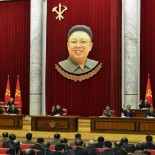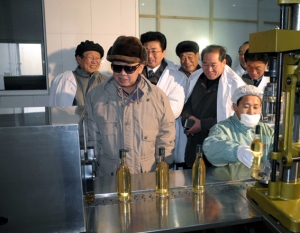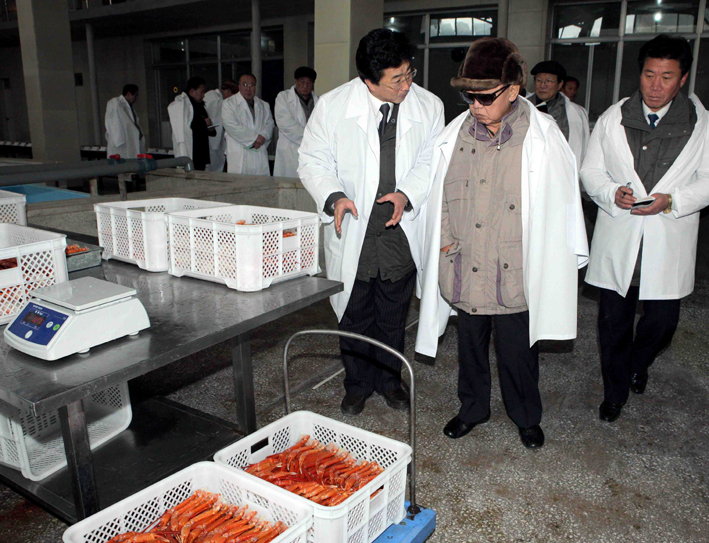Guidance: North by Northeast
En coda
Kim Jong-il visited the Songjin Iron and Steel Complex in the city of Kim Chaek, possibly on Friday (the North Korean press is not putting dates on these activities). General-Secretary Kim praised the workers and party functionaries to the hilt, and ladled out an Order of Kim Il-sung title to two of the production units. He also visited the complex’s food factory and its health complex. Visiting the health complex, he said it was “not inferior to the Changgwang Health Complex in Pyongyang and the factory is as good as a modern foodstuff factory.” During the appearance, General-Secretary Kim was joined by the same faces who joined him at the Chongjin University of Mining and Metallurgy.
Original
(n.b. Kim Jong-il’s last reported appearance was his visit to the Pyongyang Cornstarch Factory)
Kim Jong-il and the “people’s train, the train of love” powered up to the coastal area of North Hamgyong for three (3) guidance tours this past week. The guidance train traveled to Rason (or Rajin-Sonbong), one of the DPRK’s “free trade zones” (although this status and the city’s administration are sometimes shuffled by the Central Party). Yonhap and I were both wrong that this was his first visit to Rason. He inspected the DPRK-Russia Friendship House in Rason in 2005. General-Secretary Kim visited the Korea Rason Taehung Trading Company (located here), which exports processed food seafood (fish, sea urchin) and wine to China and Russia, among others. Kim Jong-il toured the fish farms, the processing plant and the winery. General-Secretary Kim was reported to be in his now customary effusive mood: “He highly appreciated the feats performed by the officials and workers of the company, expressing great satisfaction. . .” and “He was greatly pleased. . .and highly appreciated the revolutionary spirit of self-reliance displayed by them.”
During the tour Kim Jong-il set policies around the DPRK’s deficiencies in rail and port facilities “in order to satisfactorily ensure the transport of freight for trade.” General-Secretary Kim remarked: “As it is very important to abide by the principle of the credit-first policy in foreign trade it is necessary to pay deep attention to this matter. To this end, it is essential to intensify the drive for strictly observing the export discipline and improve the quality of goods.” Through the propagandic diction of KCNA reporting, General-Secretary Kim went about setting, or reiterating, North Korean export policies that presumably only apply to Rason.

The Guard Command has found the coat, which is now appropriately draped. Check out the expression on Jang Song-thaek (second from right) who is not amused at this presentation. (Photo: KCNA)
Kim Jong-il and his travel party then hopped into its motorcade of black Mercedes Benz sedans and rode into Rajin’s city center and port. Despite having a special administrative designation, Rajin still retains the trappings of a major North Korean city with the revolutionary museum, the Kim Il-sung Immortality Trident, slogan monuments, statues and missile batteries. General-Secretary Kim was briefed by the Party and municipal authorities on “city construction and management.” He “call[ed] for building the city well under a long-term plan and pay special attention to the party and administrative work in the city. . .and he specified tasks and ways to do so.”
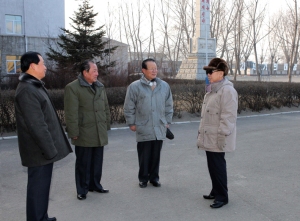
General-Secretary Kim exchanging civilities with the officials at Chongjin University of Mining and Metallurgy (Photo: KCNA).
A day or two later, Kim Jong-il made two appearances in Chongjin, North Hamgyong’s provincial capital. He first conducted an inspection tour of the Chongjin University of Mining and Metallurgy(located here). He toured the campus (“the hydraulic machine research room, the metal engineering laboratory, the comprehensive analytical laboratory, the IT operation room, the E-library”). He conveyed his satisfaction with the teaching and research at the Chongjin University of Mining and Metallurgy. For the tricky endeavor making cart horses into trotters, he “underscored the need for the university to train in a brief span of time more scientists and technicians possessed of a high technical level to solve immediate issues.” He also called for the university to assume a leading role as a North Korean science and technology education and made sure to show “his loving care for it.” (On a side note, Chongjin University of Mining and Metallurgy is also the alma mater of Kim Tong-un, the last known director of Office #39)
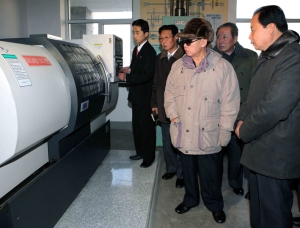
Kim Jong-il examining and being briefed on the university's CNC technology (while he jangles his pocket change or car keys). You can see CNC on the red and white label on the machine (Photo: KCNA).
General-Secretary Kim and his entourage motorcaded across Chongjin for an inspection tour of the Kim Chaek Iron and Steel Complex (located here). He toured the production facilities and “newly built blast furnace.” He was once again laudatory about the factories efforts and contributions to the North Korean economy. There were reports that Kim Chaek Iron and Steel Complex was not functioning at full capacity at the beginning of the 100 Day Battle Campaign, and that it has had to contend with power cuts. Of particular interest during his inspection is when General-Secretary Kim announced that 2010 “is a very important historic year in flinging open the gate to a thriving nation without fail in 2012.”
What is a Pyongyang watcher to do? The KCNA reports were rather abbreviated about General-Secretary Kim’s activities. Also abbreviated this past week was his schedule. In the past few weeks, General-Secretary Kim was visiting five (5) or six (6) locations, but for the week ending 20 December he was reported to have only made three (3) appearances. One factor may be the cold North Korean weather. In a musing about a possible KJI trip to China, Choson Ilbo quoted an ROK official who said General-Secretary Kim may not go, “because it’s dangerous for a person who’s had a stroke to move around in cold weather.” He certainly showed a bit of fortitude in choosing to go to Chongjin, the setting of public protest against the currency exchange. The Chongjin University of Mining and Metallurgy has close proximity to several markets. It is also likely that the security conditions around General-Secretary Kim’s presence in Chongjin presented a pretext under which the local Ministry of Public Security authorities relocated some of the local population.
With South Korean, American and Russian officials getting sore shoulders from patting their own backs over the seizure of the Il-76 in Bangkok, Kim Jong-il’s decision to emphasize foreign trade in his Rason appearance is hilarious. Taken with his appearance in Chongjin, General-Secretary Kim is signaling a certain defiance to external observers. The on the spot guidance/inspection event is a tableaux targeted to an internal and typically elite audience, but he will use them to occasionally telegraph a message to a foreign audience. He may also be trying to communicate that the DPRK being on the hook for 35 tons of weapons in Thailand won’t put a damper on the North Koreans’ new amicable attitude to the US (ROK is a whole other story). There is also a possibility that either in preparing to visit China, or to negotiate with Chinese officials, about another free trade zone near Sinuiju in North Pyongan this visit was a bit of a study tour for Kim Jong-il and his aides.
And yet, Kim Jong-il remains wary about these free trade zones. The Rason area of North Hamgyong is surrounded by an electric fence to prevent any unwanted interactions between North Korean citizens not authorized into the Rajin-Sonbong area, as well as discouraging the adventures of the few Chinese and Russian citizens working there. These security measures will certainly be part of whatever FTZ project the North Koreans pursue in North Pyongan. This month the Rason area is in its eighteenth year of operation. One may not want to ignore the significance that December 1991 sawboth General-Secretary Kim’s Rason policy initiative and later that month his appointment as KPA Supreme Commander (his final hurdle to succeeding Kim Il-sung). Rason’s FTZ status has always been circumscribed by Kim Jong-il’s remark (which passes as policy planning) that “mosquitoes must be kept inside the net.”
For those on permanent successor watch, this week’s visit to the Chongjin University of Mining and Metallurgy referred to professors and teachers “who are loyal to the party and revolution, reliable intellectuals who have single-mindedly supported the revolutionary cause of Juche with science and technology.” General-Secretary Kim also referred to “the rosy future as much revolutionary and militant intellectuals are standing firm on the front of education.” When Kim Jong-il employs this kind of rhetoric, it is a dual usage praising both the local constituency at the guidance locale and the broader segments of the North Korean population to which it can apply. The North Korean this week had other nudges and winks about a possible hereditary succession this week. On the same day as the KCNA reported General-Secretary Kim’s Rason visit, the term “CNC” appeared in a story about the Chollima Steel Complex. The 18 December volume of KCNA reports featured a story about the “Kangson spirit” (as in Kangson Steel Mill, currently known at the Chollima Steel Complex) In this iteration, Kangson spirit refers to post Korean War economic rehabilitation. However, a 2008 Rodong Sinmun essay used the Chollima Steel Complex and General-Secretary Kim’s appearance there in December in an opaque meditation on succession (” third- and fourth-generation members of the revolution. . .who highly raised the flames of succession to the cause of the revolution”).
The cohort circle is tight these days. KWP Secretary Kim Ki-nam was present this week, being Kim Jong-il’s most frequent travel companion in 2009. KWP Financial Planning Director Pak Nam-gi also had his frequent-miler ticket punched on the guidance train. Jang Song-thaek and his camera-shy wife Kim Kyong-hui rounded out the members of Kim Jong-il’s travel party. Although it does now seem Ms. Kim is coordinating her brother’s appearances. Present at all of these visits, but only identified by name in one report was OGD Senior Deputy Director Ri Je-gang. NDC Member and Second Economic Committee Vice Chair Ju Kyu-chang was in Chongjin. At all of his appearances in North Hamgyong, General-Secretary was accompanied by North Hamgyong KWP boss Hong Sok-hyong, as well as well as newly appointed North Hamgyong Provincial People’s Committee Chair Han Hung-pyo. I should note, Mr. Han is not a KJI visit virgin, having escorted General-Secretary Kim on visits to Chongjin as well as North Hamgyong. In Rason, Kim Jong-il was accompanied by Rason KWP Committee boss Kim Hyon-ju and Rason Municipal People’s Committee Chair Kim Su-yol, both of whom escorted him in 2005.
And now we wait to see what locations Kim Jong-il inspects before the end of 2009.
Additional media, photos and italicized parenthetical warning notices
KCTV News Broadcast which includes a report of Kim Jong-il’s visit to Rason (click here)
(this is an MS Powerpoint file; left double-click or right click and choose Play Movie)
Information on the Korea Rason Taehung Trading Company
(this link will take you to a DPRK-based website which may not be legal to access from some countries)

Kim Jong-il being briefed about the seafood products processed by the Rason Taehung Trading Company (Photo: KCNA).
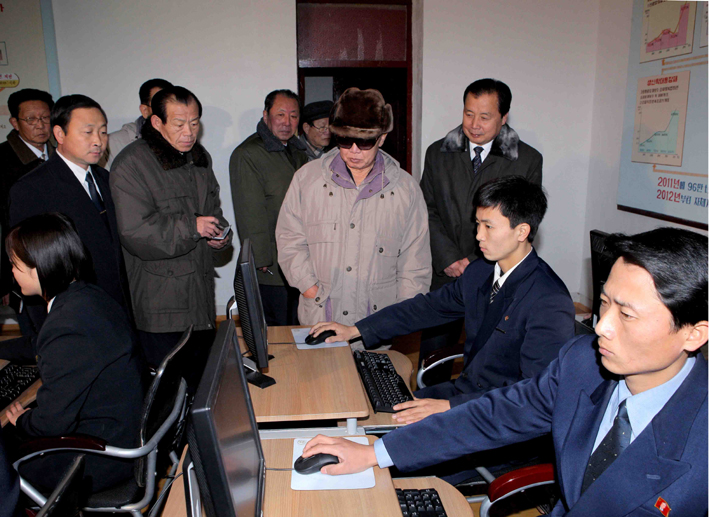
Kim Jong-il being briefed about the Chongjin University of Mining and Metallurgy's E-library (Photo: KCNA).
